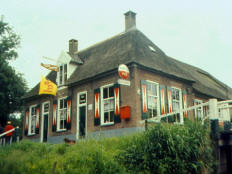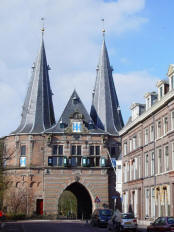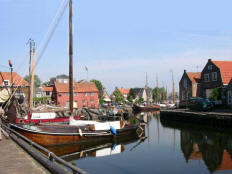After checking out of the hotel, we drove north to Apeldoorn where we planned to visit Berg en Bos Park, famous for its tulip beds and flower gardens. When we reached the park, we saw that it was much larger than we expected, and the boys had no interest in looking at flowers anyway. So we decided to continue north to Zwolle. The boys liked the massive Saxon Gate (1409) and tolerated a brief look at the ornate St. Michael’s Church (14th-15th century).
We passed through Meppel, a quaint little town on a canal and site of an operating windmill. We continued on to Staphorst, a small village where the inhabitants were purported still to wear centuries-old costumes. We drove around the village but at first didn’t see anyone. Then the church service ended, and dozens of villagers poured into the streets, all walking home in costumes.
Our next stop was Giethoorn, a village further north, built on a series of canals and without roads. We parked a short distance from a canal and found an entrepreneur who rented us a small boat with an outboard motor. The six of us barely could squeeze into the boat. We traveled north up the canal and saw several picturesque cottages along it. At first there were no other boats and no other canals. Eventually we passed a
larger canal on our left, but continued straight ahead.

Our boat glides through Giethoorn | 
A store along the canal | 
A picturesque bridge in Giethoorn |
Then, as we approached a cute wooden bridge, we met a larger boat, with a man and a cow in it, going in the opposite direction.
I pulled our boat as far to the right as possible and the other boat managed to scrape by us. But the man kept shouting and motioning at us. Finally, one of the boys told
me that we there had been a “one way” international road sign as we’d passed the other canal.
I turned the boat around and started back. But when we reached the other canal (now on our right), we saw that there was a “one-way” sign on the canal we’d come from. So we couldn’t go back that way (south) to return the boat. Our only choice was to take the canal to our right (east).
We really weren’t sure where we were going.
I had a brief glance at a map of Giethoorn when we first came into the village.
I thought I recalled that a long lake ran parallel to the canal system. And
I figured if we could get to the lake, we could go south and re-enter the canal below where we’d rented the boat.
The canal soon widened considerably, and there were many houses up on its high bank. Eventually
I saw a man walking up there. I quickly tied our boat to a pier and scrambled up the bank to ask directions. The man looked like he was from the old Holland we’d read about in elementary school. He wore wooden shoes (sabots), stockings, knee-length pants (knickers), a wrinkled shirt with a vest, a red kerchief around his neck, and a tiny cap. He was smoking a large pipe.
I approached him and asked in German if this canal went into the lake. The man studied
me, took a long pull on his pipe, then asked in Dutch (close enough to German that
I could understand), “Are you German?” When I said I was not, the man asked, “Then why are you speaking German?” Nonplused,
I started to explain (in German) that I thought he was more likely to understand German than English. The man replied, "If you can speak German, you can speak Dutch." With that, he turned and walked away, still puffing on his pipe.
I returned to our boat and continued going east. Much to our relief, we soon came to a large lake (the Boven Wijde, we found out later). Heading south far enough to get below our starting point, we eventually found another canal. We still weren’t sure it led back to where we’d rented the boat, but we lucked out. We returned the boat and retrieved our car. Then we had lunch in Giethoorn, delicious pannekoeken (pancakes) with strawberries and apples.

Broederpoort in Kampen
|
We drove back down to Kampen, taking a ferry across the Zwarte Meer on the way. Kampen is an old town with a picturesque gate, but we’d come this way to see some of the reclamation projects by which the Dutch took back land from the sea.
In 1932, the Dutch completed a dike that closed off the Zuidersee from the sea, making it a lake (IJsselmeer). Over the years, parts of the new lake have been converted to agricultural land called polders. The first polder (north) was reclaimed about 1942, another about 1957 (east), and the latest about 1968 (south). In the early days, windmills were used to pump out the water. The older polders now have dry fields covered with crops or herds of dairy cattle. There are large trees and even houses.
Just beyond Kampen we crossed to a reclaimed polder and drove along the dike. As to be expected, the land was as flat as can be, but it seemed to be completely cultivated. Past Harderwijk, an old fishing village that no longer had access to the sea, the newest polder was being developed. Although reclaimed two years earlier, it was far from being ready for cultivation. It was fascinating to see the magnitude and the results of the project. Even the boys found it interesting.

Polder mid-way through draining process | 
Windmills used for early projects | 
A fully developed polder |

Spakenburg harbor |

Spakenburg ladies in costumes |
We drove on to Spakenburg and Bunschoten, twin fishing and farming villages now combined. Residents are known for the continued wear of old costumes, and we saw many of them. There were also small fishing boats even though the new polder leaves only a small channel to the lake.
By now it was getting late and the traffic was getting heavy, so we drove straight into Amsterdam. We arrived at the Hotel Paap about 19:00. It was located close in (Keizersgracht
#39) right on a central canal. Like most buildings in that area, it was very narrow, no more than 15 feet wide. The boy’s rooms were on the second floor and ours on the third, but the winding staircase was too narrow for a person to carry a large suitcase up it. The owner had to hoist our luggage up on the outside with a pulley, where we grabbed it and pulled it into the room through the window.

An example of the reistafel |
We went to the nearby Wing Wah Restaurant for dinner. It was very nice, with a strong Indonesian motif. Feeling adventuresome, we tried the rijstafel (rice table), an Indonesian specialty consisting of several different dishes. It was a little different, but generally very good. The boys ate heartily with no complaints.
We knew the Dutch had colonized much of that area for centuries, but were still surprised at how strong the Indonesian influence was in Amsterdam. After dinner we called it a day.
Page 1 2 3 4 5 6 7
Home
Copyright © 2000-2023 DarrellPeck.com All rights
reserved.